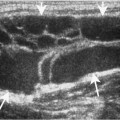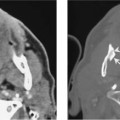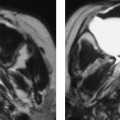Chapter 64 Cancer of the larynx is the most common head cancer and accounts for about 2% of all carcinomas. The supraglottic larynx is the second most common site of squamous cell carcinoma (SCCA) next to the true vocal cords. SCCA accounts for > 90% of cancers of the supraglottic larynx. Laryngeal cancer is more common in men (5–10:1). Patients typically present between the ages of 50 and 80. The aryepiglottic folds extend from the lateral margin of the epiglottis to the arytenoid cartilages. This is a subsite of the supraglottic larynx and is a common site for supraglottic carcinoma. All supraglottic carcinomas, including those that arise from the aryepiglottic folds, are directly related to cigarette smoking. Fortunately, the risk of tobacco-related cancers appears to be reversible; the risks for ex-smokers who have abstained from smoking for > 10 years are nearly equal to those for nonsmokers. Other forms of smoking, including cigar, pipe, and marijuana, are also felt to increase the likelihood of developing SCCA. Alcohol is the other major risk factor. Occupational exposure to oil, grease, and cement dust has also been associated with SCCA of the supraglottic larynx. The staging of supraglottic carcinoma are presented in Table 64–1. Patients usually present with hoarseness and weight loss. Aryepiglottic fold carcinomas are usually exophytic lesions. Advanced lesions may extend to adjacent sites and lead to vocal cord fixation. The paretic cord is usually due to involvement of the cricoarytenoid joint or muscle rather than involvement of the recurrent laryngeal nerve. Patients with advanced lesions may present with difficulty breathing and may require tracheotomy. Advanced tumors may invade the thyroid and cricoid cartilages. The primary echelon lymphatic drainage for aryepiglottic fold carcinomas is to nodal Groups II and III. The supraglottic larynx is rich in lymphatics, and nearly half of all patients will present with clinically positive neck metastases. Bilateral metastases will occur in up to 25% of all cases. However, in my experience, lateralized aryepiglottic fold carcinomas that do not extend to the epiglottis have a low likelihood of metastases to the contralateral neck. Thus it is important to define the full extent of disease because this may affect treatment of not only the primary site but also the neck.
Squamous Cell Carcinoma of the Aryepiglottic Fold
Epidemiology
Clinical Findings









